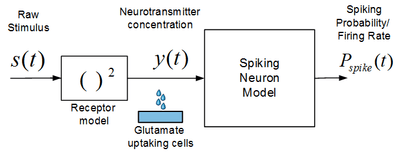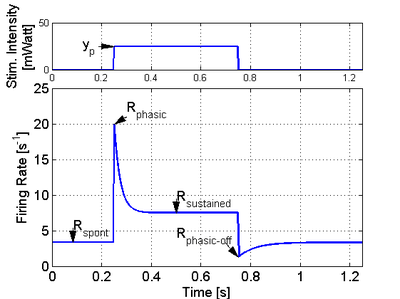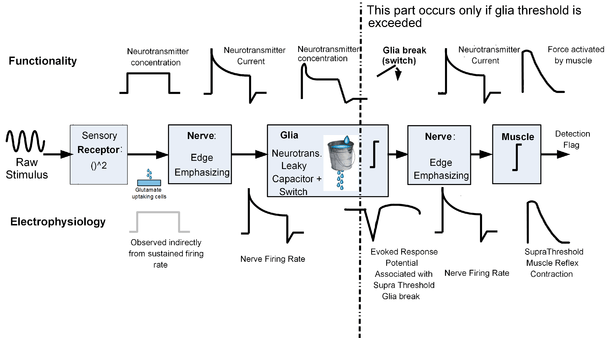Biological neuron model
A biological neuron model, also known as a spiking neuron model, is a mathematical description of the properties of certain cells in the nervous system that generate sharp electrical potentials across their cell membrane, roughly one millisecond in duration, as shown in Fig. 1. Spiking neurons are known to be a major signaling unit of the nervous system, and for this reason characterizing their operation is of great importance. It is worth noting that not all the cells of the nervous system produce the type of spike that define the scope of the spiking neuron models. For example, cochlear hair cells, retinal receptor cells, and retinal bipolar cells do not spike. Furthermore, many cells in the nervous system are not classified as neurons but instead are classified as glia.
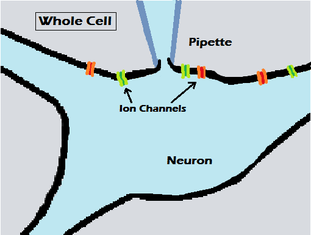
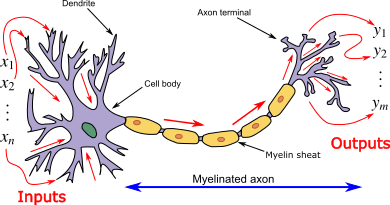
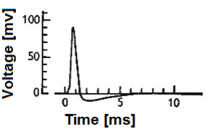
Ultimately, biological neuron models aim to explain the mechanisms underlying the operation of the nervous system for the purpose of restoring lost control capabilities such as perception (e.g. deafness or blindness), decision making, and continuous limb control. In that sense, biological neuron models differ from artificial neuron models that do not presume to predict the outcomes of experiments involving the biological neural tissue (although artificial neuron models are also concerned with execution of perception and estimation tasks). Accordingly, an important aspect of biological neuron models is experimental validation, and the use of physical units to describe the experimental procedure associated with the model predictions.
Neuron models can be divided into two categories according to the physical units of the interface of the model. Each category could be further divided according to the abstraction/detail level:
- Electrical input–output membrane voltage models – These models produce a prediction for membrane output voltage as function of electrical stimulation at the input stage (either voltage or current). The various models in this category differ in the exact functional relationship between the input current and the output voltage and in the level of details. Some models in this category are black box models and distinguish only between two measured voltage levels: the presence of a spike (also known as "action potential") or a quiescent state. Other models are more detailed and account for sub-cellular processes.
- Natural or pharmacological input neuron models – The models in this category connect between the input stimulus which can be either pharmacological or natural, to the probability of a spike event. The input stage of these models is not electrical, but rather has either pharmacological (chemical) concentration units, or physical units that characterize an external stimulus such as light, sound or other forms of physical pressure. Furthermore, the output stage represents the probability of a spike event and not an electrical voltage. Typically, this output probability is normalized (divided by) a time constant, and the resulting normalized probability is called the "firing rate" and has units of Hertz. The probabilistic description taken by the models in this category was inspired from laboratory experiments involving either natural or pharmacological stimulation which exhibit variability in the resulting spike pattern. Nevertheless, when averaging these experimental results across several trials, a clear pattern is often revealed.
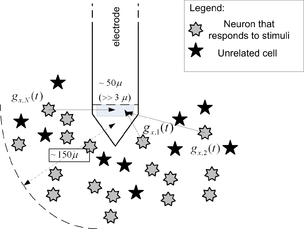
Although it is not unusual in science and engineering to have several descriptive models for different abstraction/detail levels, the number of different, sometimes contradicting, biological neuron models is exceptionally high. This situation is partly the result of the many different experimental settings, and the difficulty to separate the intrinsic properties of a single neuron from measurements effects and interactions of many cells (network effects). To accelerate the convergence to a unified theory, we list several models in each category, and where applicable, also references to supporting experiments.
Electrical input–output membrane voltage models
The models in this category describe the relationship between neuronal membrane currents at the input stage, and membrane voltage at the output stage. The most extensive experimental inquiry in this category of models was made by Hodgkin–Huxley in the early 1950s using an experimental setup that punctured the cell membrane and allowed to force a specific membrane voltage/current.
Most modern electrical neural interfaces apply extra-cellular electrical stimulation to avoid membrane puncturing which can lead to cell death and tissue damage. Hence, it is not clear to what extent the electrical neuron models hold for extra-cellular stimulation (see e.g.[1]).
Integrate-and-fire
One of the earliest models of a neuron was first investigated in 1907 by Louis Lapicque.[2] A neuron is represented in time by
which is just the time derivative of the law of capacitance, Q = CV. When an input current is applied, the membrane voltage increases with time until it reaches a constant threshold Vth, at which point a delta function spike occurs and the voltage is reset to its resting potential, after which the model continues to run. The firing frequency of the model thus increases linearly without bound as input current increases.
The model can be made more accurate by introducing a refractory period tref that limits the firing frequency of a neuron by preventing it from firing during that period. Through some calculus involving a Fourier transform, the firing frequency as a function of a constant input current thus looks like
- .
A remaining shortcoming of this model is that it implements no time-dependent memory. If the model receives a below-threshold signal at some time, it will retain that voltage boost forever until it fires again. This characteristic is clearly not in line with observed neuronal behavior.
Hodgkin–Huxley
| Property of the H&H model | References |
|---|---|
| The shape of an individual spike | [3][4][5][6] |
| The identity of the ions involved | [3][4][5][6] |
| Spike speed across the axon | [3] |
The Hodgkin–Huxley model (H&H model)[3][4][5][6] is a model of the relationship between the flow of ionic currents across the neuronal cell membrane and the membrane voltage of the cell.[3][4][5][6] It consists of a set of nonlinear differential equations describing the behaviour of ion channels that permeate the cell membrane of the squid giant axon. Hodgkin and Huxley were awarded the 1963 Nobel Prize in Physiology or Medicine for this work.
We note as before our voltage-current relationship, this time generalized to include multiple voltage-dependent currents:
- .
Each current is given by Ohm's law as
where g(t,V) is the conductance, or inverse resistance, which can be expanded in terms of its constant average ḡ and the activation and inactivation fractions m and h, respectively, that determine how many ions can flow through available membrane channels. This expansion is given by
and our fractions follow the first-order kinetics
with similar dynamics for h, where we can use either τ and m∞ or α and β to define our gate fractions.
The Hodgkin–Huxley model may be expanded to include additional ionic currents. Typically, these include inward Ca2+ and Na+ input currents, as well as several varieties of K+ outward currents, including a "leak" current.
The end result can be at the small end 20 parameters which one must estimate or measure for an accurate model, and for complex systems of neurons not easily tractable by computer. Careful simplifications of the Hodgkin–Huxley model are therefore needed.
Leaky integrate-and-fire
In the leaky integrate-and-fire model, also studied by Louis Lapicque,[7] the memory problem is solved by adding a "leak" term to the membrane potential, reflecting the diffusion of ions that occurs through the membrane when some equilibrium is not reached in the cell. The model looks like
where Rm is the membrane resistance, as we find it is not a perfect insulator as assumed previously. This forces the input current to exceed some threshold Ith = Vth / Rm in order to cause the cell to fire, else it will simply leak out any change in potential. The firing frequency thus looks like
which converges for large input currents to the previous leak-free model with refractory period.[8] The model can also be extended to inhibitory neurons.[9]
Fractional-order leaky integrate-and-fire
Recent advances in computational and theoretical fractional calculus lead to a new form of model, called Fractional-order leaky integrate-and-fire developed by Teka et al. The great advantage of this model is that it can capture and integrate all the past activities and can reproduce the time dependent spiking adaptations observed on pyramidal neurons. The model has the following form - more details can be found in.[10]
Galves–Löcherbach
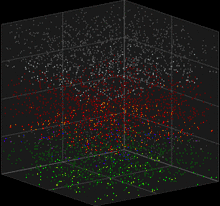
The Galves–Löcherbach model is a specific development of the leaky integrate-and-fire model. It is inherently stochastic. It was developed by mathematicians Antonio Galves and Eva Löcherbach.[11] Given the model specifications, the probability that a given neuron spikes in a time period may be described by
where is a synaptic weight, describing the influence of neuron on neuron , expresses the leak, and provides the spiking history of neuron before , according to
Exponential integrate-and-fire
In the exponential integrate-and-fire model, spike generation is exponential, following the equation:
- .
where is the membrane potential, is the membrane potential threshold, is the membrane time constant, is the resting potential, and is the sharpness of action potential initiation, usually around 1 mV for cortical pyramidal neurons. Once the membrane potential crosses , it diverges to infinity in finite time.[12][13][14]
FitzHugh–Nagumo
Sweeping simplifications to Hodgkin–Huxley were introduced by FitzHugh and Nagumo in 1961 and 1962. Seeking to describe "regenerative self-excitation" by a nonlinear positive-feedback membrane voltage and recovery by a linear negative-feedback gate voltage, they developed the model described by
where we again have a membrane-like voltage and input current with a slower general gate voltage w and experimentally-determined parameters a = -0.7, b = 0.8, τ = 1/0.08. Although not clearly derivable from biology, the model allows for a simplified, immediately available dynamic, without being a trivial simplification.[15]
Morris–Lecar
In 1981 Morris and Lecar combined the Hodgkin–Huxley and FitzHugh–Nagumo models into a voltage-gated calcium channel model with a delayed-rectifier potassium channel, represented by
where .[8]
Hindmarsh–Rose
Building upon the FitzHugh–Nagumo model, Hindmarsh and Rose proposed in 1984 a model of neuronal activity described by three coupled first order differential equations:
with r2 = x2 + y2 + z2, and r ≈ 10−2 so that the z variable only changes very slowly. This extra mathematical complexity allows a great variety of dynamic behaviors for the membrane potential, described by the x variable of the model, which include chaotic dynamics. This makes the Hindmarsh–Rose neuron model very useful, because being still simple, allows a good qualitative description of the many different patterns of the action potential observed in experiments.
Cable theory
Cable theory describes the dendritic arbor as a cylindrical structure undergoing a regular pattern of bifurcation, like branches in a tree. For a single cylinder or an entire tree, the input conductance at the base (where the tree meets the cell body, or any such boundary) is defined as
- ,
where L is the electrotonic length of the cylinder which depends on its length, diameter, and resistance. A simple recursive algorithm scales linearly with the number of branches and can be used to calculate the effective conductance of the tree. This is given by
where AD = πld is the total surface area of the tree of total length l, and LD is its total electrotonic length. For an entire neuron in which the cell body conductance is GS and the membrane conductance per unit area is Gmd = Gm / A, we find the total neuron conductance GN for n dendrite trees by adding up all tree and soma conductances, given by
- ,
where we can find the general correction factor Fdga experimentally by noting GD = GmdADFdga.
Compartmental models
The cable model makes a number of simplifications to give closed analytic results, namely that the dendritic arbor must branch in diminishing pairs in a fixed pattern. A compartmental model allows for any desired tree topology with arbitrary branches and lengths, but makes simplifications in the interactions between branches to compensate. Thus, the two models give complementary results, neither of which is necessarily more accurate.
Each individual piece, or compartment, of a dendrite is modeled by a straight cylinder of arbitrary length l and diameter d which connects with fixed resistance to any number of branching cylinders. We define the conductance ratio of the ith cylinder as Bi = Gi / G∞, where and Ri is the resistance between the current compartment and the next. We obtain a series of equations for conductance ratios in and out of a compartment by making corrections to the normal dynamic Bout,i = Bin,i+1, as
where the last equation deals with parents and daughters at branches, and . We can iterate these equations through the tree until we get the point where the dendrites connect to the cell body (soma), where the conductance ratio is Bin,stem. Then our total neuron conductance is given by
- .
An example of a compartmental model of a neuron, with an algorithm to reduce the number of compartments (increase the computational speed) and yet retain the salient electrical characteristics, can be found in.[16]
Natural input stimulus neuron models
The models in this category were derived following experiments involving natural stimulation such as light, sound, touch, or odor. In these experiments, the spike pattern resulting from each stimulus presentation varies from trial to trial, but the averaged response from several trials often converges to a clear pattern. Consequently, the models in this category generate a probabilistic relationship between the input stimulus to spike occurrences.
The non-homogeneous Poisson process model (Siebert)
Siebert[17][18] modeled the neuron spike firing pattern using a non-homogeneous Poisson process model, following experiments involving the auditory system.[17][18] According to Siebert, the probability of a spiking event at the time interval is proportional to a non negative function , where is the raw stimulus.:
Siebert considered several functions as , including for low stimulus intensities.
The main advantage of Siebert's model is its simplicity. The shortcomings of the model is its inability to reflect properly the following phenomena:
- The edge emphasizing property of the neuron in response to a stimulus pulse.
- The saturation of the firing rate.
- The values of inter-spike-interval-histogram at short intervals values (close to zero).
These shortcoming are addressed by the two state Markov Model.[19][20][21]
The two state Markov model (Nossenson & Messer)
The spiking neuron model by Nossenson & Messer[19][20][21] produces the probability of the neuron to fire a spike as a function of either an external or pharmacological stimulus.[19][20][21] The model consists of a cascade of a receptor layer model and a spiking neuron model, as shown in Fig 4. The connection between the external stimulus to the spiking probability is made in two steps: First, a receptor cell model translates the raw external stimulus to neurotransmitter concentration, then, a spiking neuron model connects between neurotransmitter concentration to the firing rate (spiking probability). Thus, the spiking neuron model by itself depends on neurotransmitter concentration at the input stage.[19][20][21]
An important feature of this model is the prediction for neurons firing rate pattern which captures, using a low number of free parameters, the characteristic edge emphasized response of neurons to a stimulus pulse, as shown in Fig. 5. The firing rate is identified both as a normalized probability for neural spike firing, and as a quantity proportional to the current of neurotransmitters released by the cell. The expression for the firing rate takes the following form:
where,
- P0 is the probability of the neuron to be "armed" and ready to fire. It is given by the following differential equation:
P0 could be generally calculated recursively using Euler method, but in the case of a pulse of stimulus it yields a simple closed form expression.[19][22]
- y(t) is the input of the model and is interpreted as the neurotransmitter concentration on the cell surrounding (in most cases glutamate) . For an external stimulus it can be estimated through the receptor layer model:
, with being short temporal average of stimulus power (given in Watt or other energy per time unit).
- R0 corresponds to the intrinsic spontaneous firing rate of the neuron.
- R1 is the recovery rate of the neuron from refractory state.
Other predictions by this model include:
1) The averaged Evoked Response Potential (ERP) due to population of many neurons in unfiltered measurements resembles the firing rate.[21]
2) The voltage variance of activity due to multiple neuron activity resembles the firing rate (also known as Multi-Unit-Activity power or MUA).[20][21]
3) The inter-spike-interval probability distribution takes the form a gamma-distribution like function.[19][22]
| Property of the Model by Nossenson & Messer | References | Description of experimental evidence |
|---|---|---|
| The shape of the firing rate in response to an auditory stimulus pulse | [23][24][25][26][27] | The Firing Rate has the same shape of Fig 5. |
| The shape of the firing rate in response to a visual stimulus pulse | [28][29][30][31] | The Firing Rate has the same shape of Fig 5. |
| The shape of the firing rate in response to an olfactory stimulus pulse | [32] | The Firing Rate has the same shape of Fig 5. |
| The shape of the firing rate in response to a somato-sensory stimulus | [33] | The Firing Rate has the same shape of Fig 5. |
| The change in firing rate in response to neurotransmitter application (mostly glutamate) | [34][35] | Firing Rate change in response to neurotransmitter application (Glutamate) |
| Square dependence between an auditory stimulus pressure and the firing rate | [36] | Square Dependence between Auditory Stimulus pressure and the Firing Rate (- Linear dependence in pressure square (power)). |
| Square dependence between visual stimulus electric field (volts) and the firing rate | [29] | Square dependence between visual stimulus electric field (volts) - Linear Dependence between Visual Stimulus Power and the Firing Rate. |
| The shape of the Inter-Spike-Interval Statistics (ISI) | [37] | ISI shape resembles the gamma-function-like |
| The ERP resembles the firing rate in unfiltered measurements | [38] | The shape of the averaged evoked response potential in response to stimulus resembles the firing rate (Fig. 5). |
| MUA power resembles the firing rate | [21][39] | The shape of the empirical variance of extra-cellular measurements in response to stimulus pulse resembles the firing rate (Fig. 5). |
Non-Markovian models
The following is a list of published non-Markovian neuron models:
Theta model
The theta model, or Ermentrout–Kopell canonical model, is a model originally developed to model neurons in the animal Aplysia, and is particularly well suited to describe neuron parabolic bursting.[43]
Pharmacological input stimulus neuron models
The models in this category produce predictions for experiments involving pharmacological stimulation.
Synaptic transmission (Koch & Segev)
According to the model by Koch and Segev,[8] the response of a neuron to individual neurotransmitters can be modeled as an extension of the classical Hodgkin–Huxley model with both standard and nonstandard kinetic currents. Four neurotransmitters primarily have influence in the CNS. AMPA/kainate receptors are fast excitatory mediators while NMDA receptors mediate considerably slower currents. Fast inhibitory currents go through GABAA receptors, while GABAB receptors mediate by secondary G-protein-activated potassium channels. This range of mediation produces the following current dynamics:
where ḡ is the maximal[3][8] conductance (around 1S) and E is the equilibrium potential of the given ion or transmitter (AMDA, NMDA, Cl, or K), while [O] describes the fraction of receptors that are open. For NMDA, there is a significant effect of magnesium block that depends sigmoidally on the concentration of intracellular magnesium by B(V). For GABAB, [G] is the concentration of the G-protein, and Kd describes the dissociation of G in binding to the potassium gates.
The dynamics of this more complicated model have been well-studied experimentally and produce important results in terms of very quick synaptic potentiation and depression, that is, fast, short-term learning.
The two state Markov model (Nossenson & Messer)
The model by Nossenson and Messer translates neurotransmitter concentration at the input stage to the probability of releasing neurotransmitter at the output stage.[19][20][21] For a more detailed description of this model, see the Two state Markov model section above.
HTM neuron model
The HTM neuron model was developed by Jeff Hawkins and researchers at Numenta and is based on a theory called Hierarchical Temporal Memory, originally described in the book On Intelligence. It is based on neuroscience and the physiology and interaction of pyramidal neurons in the neocortex of the human brain.
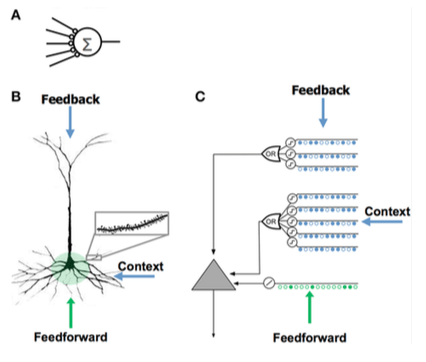
| - Few synapses
- No dendrites - Sum input x weights - Learns by modifying weights of synapses |
- Thousands of synapses on the dendrites
- Active dendrites: cell recognizes hundreds of unique patterns - Co-activation of a set of synapses on a dendritic segment causes an NMDA spike and depolarization at the soma - Sources of input to the cell:
- Learns by growing new synapses |
- Inspired by the pyramidal cells in neocortex layers 2/3 and 5
- Thousands of synapses - Active dendrites: cell recognizes hundreds of unique patterns - Models dendrites and NMDA spikes with each array of coincident detectors having a set of synapses - Learns by modeling growth of new synapses |
Applications
The question of neural modeling is at the heart of the following projects:
Neurotransmitter-based retinal prosthesis
Relation between artificial and biological neuron models
The most basic model of a neuron consists of an input with some synaptic weight vector and an activation function or transfer function inside the neuron determining output. This is the basic structure used for artificial neurons, which in a neural network often looks like
where yi is the output of the i th neuron, xj is the jth input neuron signal, wij is the synaptic weight (or strength of connection) between the neurons i and j, and φ is the activation function. While this model has seen success in machine-learning applications, it is a poor model for real (biological) neurons, because it lacks the time-dependence that real neuron spikes exhibit. Biological models of the "integrate-and-fire" type take essentially this form; in medical and pharmacological literature they have largely been superseded by kinetic models such as the Hodgkin–Huxley model.
In the case of modelling a biological neuron, physical analogues are used in place of abstractions such as "weight" and "transfer function". A neuron is filled and surrounded with water containing ions, which carry electric charge. The neuron is bound by an insulating cell membrane and can maintain a concentration of charged ions on either side that determines a capacitance Cm. The firing of a neuron involves the movement of ions into the cell that occurs when neurotransmitters cause ion channels on the cell membrane to open. We describe this by a physical time-dependent current I(t). With this comes a change in voltage, or the electrical potential energy difference between the cell and its surroundings, which is observed to sometimes result in a voltage spike called an action potential which travels the length of the cell and triggers the release of further neurotransmitters. The voltage, then, is the quantity of interest and is given by Vm(t)[9].
Conjectures regarding the role of the neuron in the wider context of the brain principle of operation
The neurotransmitter-based energy detection scheme
The neurotransmitter-based energy detection scheme[21][22] suggests that the neural tissue chemically executes a Radar-like detection procedure.
As shown in Fig. 6, the key idea of the conjecture is to account neurotransmitter concentration, neurotransmitter generation and neurotransmitter removal rates as the important quantities in executing the detection task, while referring to the measured electrical potentials as a side effect that only in certain conditions coincide with the functional purpose of each step. The detection scheme is similar to a radar like "energy detection" because it includes signal squaring, temporal summation and a threshold switch mechanism, just like the energy detector, but it also includes a unit that emphasizes stimulus edges and a variable memory length (variable memory). According to this conjecture, the physiological equivalent of the energy test statistics is neurotransmitter concentration, and the firing rate corresponds to neurotransmitter current. The advantage of this interpretation is that it leads to a unit consistent explanation which allows to bridge between electrophysiological measurements, biochemical measurements and psychophysical results.
The evidence reviewed in[21][22] suggest the following association between functionality to histological classification:
- Stimulus squaring is likely to be performed by receptor cells.
- Stimulus edge emphasizing and signal transduction is performed by neurons.
- Temporal accumulation of neurotransmitters is performed by glia cells. Short term neurotransmitter accumulation is likely to occur also in some types of neurons.
- Logical switching is executed by glia cells, and it results from exceeding a threshold level of neurotransmitter concentration. This threshold crossing is also accompanied by a change in neurotransmitter leak rate.
- Physical all-or-non movement switching is due to muscle cells and results from exceeding a certain neurotransmitter concentration threshold on muscle surroundings.
Note that although the electrophysiological signals in Fig.6 are often similar to the functional signal (signal power / neurotransmitter concentration / muscle force), there are some stages in which the electrical observation is different from the functional purpose of the corresponding step. In particular, Nossenson et al. suggested that glia threshold crossing has a completely different functional operation compared to the radiated electrophysiological signal, and that the latter might only be a side effect of glia break.
General comments regarding the modern perspective of scientific and engineering models
- The models above are still idealizations. Corrections must be made for the increased membrane surface area given by numerous dendritic spines, temperatures significantly hotter than room-temperature experimental data, and nonuniformity in the cell's internal structure.[8] Certain observed effects do not fit into some of these models. For instance, the temperature cycling (with minimal net temperature increase) of the cell membrane during action potential propagation not compatible with models which rely on modeling the membrane as a resistance which must dissipate energy when current flows through it. The transient thickening of the cell membrane during action potential propagation is also not predicted by these models, nor is the changing capacitance and voltage spike that results from this thickening incorporated into these models. The action of some anesthetics such as inert gases is problematic for these models as well. New models, such as the soliton model attempt to explain these phenomena, but are less developed than older models and have yet to be widely applied.
- Modern views regarding of the role of the scientific model suggest that "All models are wrong but some are useful" (Box and Draper, 1987, Gribbin, 2009; Paninski et al., 2009).
- Recent conjecture suggests that each neuron might function as a collection of independent threshold units. It is suggested that a neuron could be anisotropically activated following the origin of its arriving signals to the membrane, via its dendritic trees. The spike waveform was also proposed to be dependent on the origin of the stimulus.[50]
See also
References
- Mathieson, Keith; Loudin, James; Goetz, Georges; Huie, Philip; Wang, Lele; Kamins, Theodore I.; Galambos, Ludwig; Smith, Richard; Harris, James S. (2012-12-01). "Photovoltaic retinal prosthesis with high pixel density". Nature Photonics. 6 (12): 391–397. Bibcode:2012NaPho...6..391M. doi:10.1038/nphoton.2012.104. ISSN 1749-4885. PMC 3462820. PMID 23049619.
- Abbott, L.F. (1999). "Lapique's introduction of the integrate-and-fire model neuron (1907)" (PDF). Brain Research Bulletin. 50 (5/6): 303–304. doi:10.1016/S0361-9230(99)00161-6. PMID 10643408. Archived from the original (PDF) on 2007-06-13. Retrieved 2007-11-24.
- Hodgkin, A. L.; Huxley, A. F. (1952). "A quantitative description of membrane current and its application to conduction and excitation in nerve". The Journal of Physiology. 117 (4): 500–544. doi:10.1113/jphysiol.1952.sp004764. PMC 1392413. PMID 12991237.
- Hodgkin, A. L.; Huxley, A. F.; Katz, B. (1952-04-28). "Measurement of current-voltage relations in the membrane of the giant axon of Loligo". The Journal of Physiology. 116 (4): 424–448. doi:10.1113/jphysiol.1952.sp004716. ISSN 1469-7793. PMC 1392219. PMID 14946712.
- Hodgkin, A. L.; Huxley, A. F. (1952-04-28). "Currents carried by sodium and potassium ions through the membrane of the giant axon of Loligo". The Journal of Physiology. 116 (4): 449–472. doi:10.1113/jphysiol.1952.sp004717. ISSN 1469-7793. PMC 1392213. PMID 14946713.
- Hodgkin, A. L.; Huxley, A. F. (1952-04-28). "The components of membrane conductance in the giant axon of Loligo". The Journal of Physiology. 116 (4): 473–496. doi:10.1113/jphysiol.1952.sp004718. ISSN 1469-7793. PMC 1392209. PMID 14946714.
- Abbott, L.F. (1999). "Lapique's introduction of the integrate-and-fire model neuron (1907)" (PDF). Brain Research Bulletin. 50 (5/6): 303–304. doi:10.1016/S0361-9230(99)00161-6. PMID 10643408. Archived from the original (PDF) on 2007-06-13. Retrieved 2007-11-24.
- Koch, Christof; Segev, Idan (1999). Methods in neuronal modeling : from ions to networks (2nd ed.). Cambridge, Massachusetts: MIT Press. p. 687. ISBN 978-0-262-11231-4. Archived from the original on 2011-07-07. Retrieved 2013-01-10.
- Cejnar, Pavel; Vyšata, Oldřich; Kukal, Jaromír; Beránek, Martin; Vališ, Martin; Procházka, Aleš (2020). "Simple capacitor-switch model of excitatory and inhibitory neuron with all parts biologically explained allows input fire pattern dependent chaotic oscillations". Scientific Reports. 10 (1): 7353. doi:10.1038/s41598-020-63834-7. PMC 7192907. PMID 32355185.
- Teka, Wondimu W.; Marinov, Toma M.; Santamaria, Fidel (2014). "Neuronal spike timing adaptation described with a fractional leaky integrate-and-fire model". PLOS Comput Biol. 10 (3): e1003526. Bibcode:2014PLSCB..10E3526T. doi:10.1371/journal.pcbi.1003526. PMC 3967934. PMID 24675903.
- Galves, A.; Löcherbach, E. (2013). "Infinite Systems of Interacting Chains with Memory of Variable Length — A Stochastic Model for Biological Neural Nets". Journal of Statistical Physics. 151 (5): 896–921. arXiv:1212.5505. Bibcode:2013JSP...151..896G. doi:10.1007/s10955-013-0733-9.
- Badel, Laurent; Lefort, Sandrine; Brette, Romain; Petersen, Carl C. H.; Gerstner, Wulfram; Richardson, Magnus J. E. (February 2008). "Dynamic I-V curves are reliable predictors of naturalistic pyramidal-neuron voltage traces". Journal of Neurophysiology. 99 (2): 656–666. CiteSeerX 10.1.1.129.504. doi:10.1152/jn.01107.2007. ISSN 0022-3077. PMID 18057107.
- Ostojic, S.; Brunel, N.; Hakim, V. (2009). "How Connectivity, Background Activity, and Synaptic Properties Shape the Cross-Correlation between Spike Trains". Journal of Neuroscience. 29 (33): 10234–10253. doi:10.1523/JNEUROSCI.1275-09.2009. PMC 6665800. PMID 19692598.
- Badel, L.; Lefort, S.; Brette, R.; Petersen, C. C. H.; Gerstner, W.; Richardson, M. J. E. (2008). "Dynamic I-V curves are reliable predictors of naturalistic pyramidalneuron voltage traces". Journal of Neurophysiology. 99 (2): 656–666. doi:10.1152/jn.01107.2007. PMID 18057107.
- FitzHugh, R.; Izhikevich, E. (2006). "FitzHugh-Nagumo model". Scholarpedia. 1 (9): 1349. Bibcode:2006SchpJ...1.1349I. doi:10.4249/scholarpedia.1349.
- Forrest MD (April 2015). "Simulation of alcohol action upon a detailed Purkinje neuron model and a simpler surrogate model that runs >400 times faster". BMC Neuroscience. 16 (27): 27. doi:10.1186/s12868-015-0162-6. PMC 4417229. PMID 25928094.
- Siebert, W. M. (1970-05-01). "Frequency discrimination in the auditory system: Place or periodicity mechanisms?". Proceedings of the IEEE. 58 (5): 723–730. doi:10.1109/PROC.1970.7727. ISSN 0018-9219.
- Siebert, William M. (1965-06-01). "Some implications of the stochastic behavior of primary auditory neurons". Kybernetik. 2 (5): 206–215. doi:10.1007/BF00306416. ISSN 0023-5946. PMID 5839007.
- Nossenson, Nir; Messer, Hagit (2010). "Modeling neuron firing pattern using a two state Markov chain". 2010 IEEE Sensor Array and Multichannel Signal Processing Workshop. doi:10.1109/SAM.2010.5606761. ISBN 978-1-4244-8978-7.
- Nossenson, N.; Messer, H. (2012). "Optimal sequential detection of stimuli from multiunit recordings taken in densely populated brain regions". Neural Computation. 24 (4): 895–938. doi:10.1162/NECO_a_00257. PMID 22168560.
- Nossenson, N.; Magal, N.; Messer, H. (2016). "Detection of stimuli from multi-neuron activity: Empirical study and theoretical implications". Neurocomputing 174 (2016): 822-837. 174: 822–837. doi:10.1016/j.neucom.2015.10.007.
- Nossenson, Nir (2013). Model Based Detection of a Stimulus Presence from Neurophysiological Signals (PDF). The Neiman Library of Exact Sciences & Engineering, Tel Aviv University: PhD diss, University of Tel-Aviv.
- Koehler, Seth D.; Pradhan, Shashwati; Manis, Paul B.; Shore, Susan E. (2011-02-01). "Somatosensory inputs modify auditory spike timing in dorsal cochlear nucleus principal cells". European Journal of Neuroscience. 33 (3): 409–420. doi:10.1111/j.1460-9568.2010.07547.x. ISSN 1460-9568. PMC 3059071. PMID 21198989.
- Reches, Amit; Gutfreund, Yoram (2008-02-06). "Stimulus-Specific Adaptations in the Gaze Control System of the Barn Owl". The Journal of Neuroscience. 28 (6): 1523–1533. doi:10.1523/JNEUROSCI.3785-07.2008. ISSN 0270-6474. PMC 6671572. PMID 18256273.
- Wang, Xiaoqin; Lu, Thomas; Snider, Ross K.; Liang, Li (2005). "Sustained firing in auditory cortex evoked by preferred stimuli". Nature. 435 (7040): 341–346. Bibcode:2005Natur.435..341W. doi:10.1038/nature03565. PMID 15902257.
- Taberner, Annette M.; Liberman, M. Charles (2005-01-01). "Response Properties of Single Auditory Nerve Fibers in the Mouse". Journal of Neurophysiology. 93 (1): 557–569. doi:10.1152/jn.00574.2004. ISSN 0022-3077. PMID 15456804.
- Hennevin, Elizabeth; Hars, Bernard; Maho, Catherine; Bloch, Vincent (1995-07-01). "Processing of learned information in paradoxical sleep: relevance for memory". Behavioural Brain Research. The Function of Sleep. 69 (1–2): 125–135. doi:10.1016/0166-4328(95)00013-J. PMID 7546303.
- Rodieck, R. W. (1965-12-01). "Quantitative analysis of cat retinal ganglion cell response to visual stimuli". Vision Research. 5 (12): 583–601. doi:10.1016/0042-6989(65)90033-7. PMID 5862581.
- Enroth-Cugell, C; Lennie, P (1975-06-01). "The control of retinal ganglion cell discharge by receptive field surrounds". The Journal of Physiology. 247 (3): 551–578. doi:10.1113/jphysiol.1975.sp010947. ISSN 1469-7793. PMC 1309488. PMID 1142301.
- Enroth-Cugell, Christina; Shapley, R. M. (1973-09-01). "Adaptation and dynamics of cat retinal ganglion cells". The Journal of Physiology. 233 (2): 271–309. doi:10.1113/jphysiol.1973.sp010308. ISSN 1469-7793. PMC 1350567. PMID 4747229.
- Sagdullaev, Botir T.; Mccall, Maureen A. (2005-09-01). "Stimulus size and intensity alter fundamental receptive-field properties of mouse retinal ganglion cells in vivo". Visual Neuroscience. 22 (5): 649–659. doi:10.1017/S0952523805225142. ISSN 1469-8714. PMID 16332276.
- Nagel, Katherine I; Wilson, Rachel I (2011). "Biophysical mechanisms underlying olfactory receptor neuron dynamics". Nature Neuroscience. 14 (2): 208–216. doi:10.1038/nn.2725. PMC 3030680. PMID 21217763.
- Tommerdahl, M.; Delemos, K. A.; Whitsel, B. L.; Favorov, O. V.; Metz, C. B. (1999-07-01). "Response of anterior parietal cortex to cutaneous flutter versus vibration". Journal of Neurophysiology. 82 (1): 16–33. doi:10.1152/jn.1999.82.1.16. ISSN 0022-3077. PMID 10400931. S2CID 14729461.
- Niktarash, Arash Hadipour; Shahidi, Gholam Ali (2004-03-01). "Effects of the Activity of the Internal Globus Pallidus-Pedunculopontine Loop on the Transmission of the Subthalamic Nucleus-External Globus Pallidus-Pacemaker Oscillatory Activities to the Cortex". Journal of Computational Neuroscience. 16 (2): 113–127. doi:10.1023/B:JCNS.0000014105.87625.5f. ISSN 0929-5313. PMID 14758061.
- Yamanaka, Yuko; Kitamura, Naoki; Shinohara, Hikaru; Takahashi, Keita; Shibuya, Izumi (2012-10-14). "Glutamate evokes firing through activation of kainate receptors in chick accessory lobe neurons". Journal of Comparative Physiology A. 199 (1): 35–43. doi:10.1007/s00359-012-0766-6. ISSN 0340-7594. PMID 23064516.
- Müller, Marcus; Robertson, Donald; Yates, Graeme K. (1991-09-01). "Rate-versus-level functions of primary auditory nerve fibres: Evidence for square law behaviour of all fibre categories in the guinea pig". Hearing Research. 55 (1): 50–56. doi:10.1016/0378-5955(91)90091-M. PMID 1752794.
- Johnson, D H; Kiang, N Y (1976-07-01). "Analysis of discharges recorded simultaneously from pairs of auditory nerve fibers". Biophysical Journal. 16 (7): 719–734. Bibcode:1976BpJ....16..719J. doi:10.1016/s0006-3495(76)85724-4. ISSN 0006-3495. PMC 1334896. PMID 938715.
- Bullock, T. H. (1997-01-01). "Comparative Physiology of Acoustic and Allied Central Analyzers". Acta Oto-Laryngologica. 117 (sup532): 13–21. doi:10.3109/00016489709126139. ISSN 0001-6489. PMID 9442839.
- Holstein, S. B.; Buchwald, J. S.; Schwafel, J. A. (1969-11-01). "Progressive changes in auditory response patterns to repeated tone during normal wakefulness and paralysis". Brain Research. 16 (1): 133–148. doi:10.1016/0006-8993(69)90090-0. PMID 5348845.
- Johnson, Don H.; Swami, Ananthram (1983-08-01). "The transmission of signals by auditory‐nerve fiber discharge patterns". The Journal of the Acoustical Society of America. 74 (2): 493–501. Bibcode:1983ASAJ...74..493J. doi:10.1121/1.389815. ISSN 0001-4966. PMID 6311884.
- Berry, Michael J.; Meister, Markus (1998-03-15). "Refractoriness and Neural Precision". The Journal of Neuroscience. 18 (6): 2200–2211. doi:10.1523/JNEUROSCI.18-06-02200.1998. ISSN 0270-6474. PMC 6792934. PMID 9482804.
- Kass, Robert E.; Ventura, Valérie (2001-08-01). "A Spike-Train Probability Model". Neural Computation. 13 (8): 1713–1720. doi:10.1162/08997660152469314. ISSN 0899-7667. PMID 11506667.
- Ermentrout, G. B.; Kopell, N. (1986). "Parabolic Bursting in an Excitable System Coupled with a Slow Oscillation". SIAM Journal on Applied Mathematics. 46 (2): 233–253. doi:10.1137/0146017. ISSN 0036-1399.
- Rizzo, Joseph F (2011). "Update on Retinal Prosthetic Research: The Boston Retinal Implant Project". Journal of Neuro-Ophthalmology. 31 (2): 160–168. doi:10.1097/wno.0b013e31821eb79e. PMID 21593628. S2CID 17213342.
- Peterman, Mark C.; Mehenti, Neville Z.; Bilbao, Kalayaan V.; Lee, Christina J.; Leng, Theodore; Noolandi, Jaan; Bent, Stacey F.; Blumenkranz, Mark S.; Fishman, Harvey A. (2003-11-01). "The Artificial Synapse Chip: A Flexible Retinal Interface Based on Directed Retinal Cell Growth and Neurotransmitter Stimulation". Artificial Organs. 27 (11): 975–985. doi:10.1046/j.1525-1594.2003.07307.x. ISSN 1525-1594. PMID 14616516.
- Iezzi, R.; Finlayson, P.; Xu, Y.; Katragadda, R. (2009-09-01). "Microfluidic neurotransmiter-based neural interfaces for retinal prosthesis". 2009 Annual International Conference of the IEEE Engineering in Medicine and Biology Society. 2009: 4563–4565. doi:10.1109/IEMBS.2009.5332694. PMID 19963838.
- Yoshida, K.; Farina, D.; Akay, M.; Jensen, W. (2010-03-01). "Multichannel Intraneural and Intramuscular Techniques for Multiunit Recording and Use in Active Prostheses". Proceedings of the IEEE. 98 (3): 432–449. doi:10.1109/JPROC.2009.2038613. ISSN 0018-9219.
- Bruns, Tim M; Wagenaar, Joost B; Bauman, Matthew J; Gaunt, Robert A; Weber, Douglas J (2013). "Real-time control of hind limb functional electrical stimulation using feedback from dorsal root ganglia recordings". Journal of Neural Engineering. 10 (2): 026020. Bibcode:2013JNEng..10b6020B. doi:10.1088/1741-2560/10/2/026020. PMC 3640462. PMID 23503062.
- "BrainGate - Home". braingate2.org. 2015-12-04. Retrieved 2016-04-06.
- Sardi, Shira; Vardi, Roni; Sheinin, Anton; Goldental, Amir; Kanter, Ido (December 2017). "New Types of Experiments Reveal that a Neuron Functions as Multiple Independent Threshold Units". Scientific Reports. 7 (1): 18036. Bibcode:2017NatSR...718036S. doi:10.1038/s41598-017-18363-1. ISSN 2045-2322. PMC 5740076. PMID 29269849.
